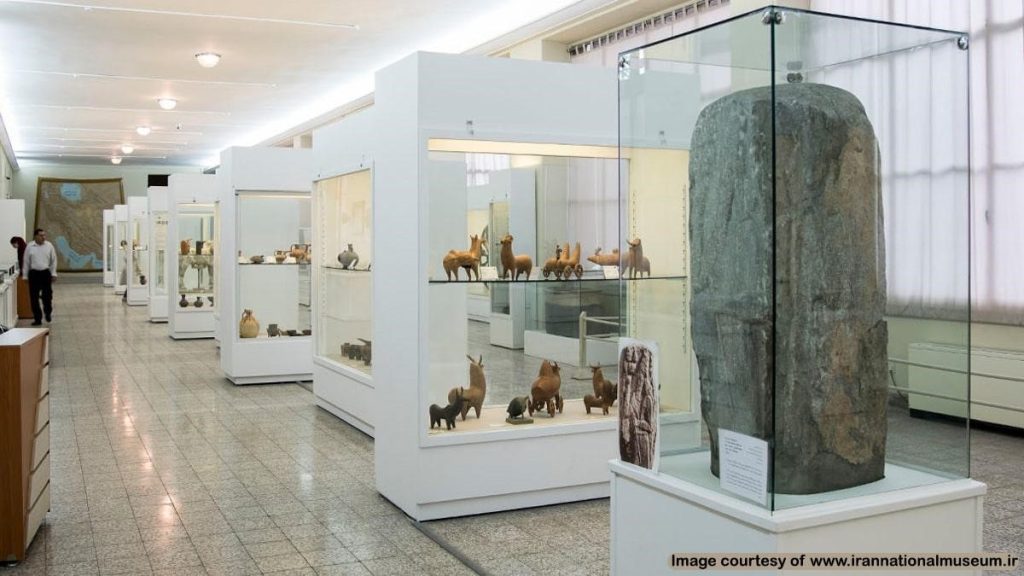
Iranian museums are part of the cultural identity of our country, and there are over 600 active public and private museums. The number of private museums in Iran is limited, roughly 100 museums. Of course, considering the rich and fascinating Iranian culture, the number of these museums is not so high. In any case, in this article, we will provide a brief definition and history of museums and a general category of Iran museums.
What Is a Museum?
Iran museums are places to display ancient or modern works of industrial, artistic, and social significance that are classified as cultural attractions. The Extraordinary General Assembly of ICOM (International Council of Museums) presented a new definition for a museum in their Aug 24, 2021 session in Prague, the Capital of the Czech Republic:
“A museum is a not-for-profit, permanent institution in the service of society that researches, collects, conserves, interprets, and exhibits tangible and intangible heritage. Open to the public, accessible and inclusive, museums foster diversity and sustainability. They operate and communicate ethically, professionally and with the participation of communities, offering varied experiences for education, enjoyment, reflection and knowledge sharing.”
History of Iran Museums
Looking at the history of museums in Iran, we realize that assembling the Mozaffareddin Shah Qajar Palace-Museum in Golestan Palace is a turning point in the institutionalization of museums in Iran. During his reign, Naser al-Din Shah Qajar ordered the demolition of the structures on the north side of this palace where he built a museum chamber, library, foyer, fountain room, and more. In the past, the Qajar kings kept royal gifts received from foreign kings in this section of the palace.
It is safe to say that Golestan Palace Compound is one of the most important and prestigious Iran museums known across the world because of the variety of literary works and artifacts, libraries, and historic documents. After museum heists during the Qajar period, showcased royal jewels were stored in the basement vault. Later, these precious objects were transferred to the Treasury of National Jewels in Iran’s Central Bank.
In addition to that, the National Museum of Iran is also one of the important museums of Iran that was established by the now-defunct Ministry of Education, Endowments, and Fine Arts in 1916. At that time, this ministry was in charge of managing education, higher education, culture and art, and endowments. Also, it seems that at the beginning of its establishment, the founder of the National Museum of Iran, Morteza Gholikhan Momtaz ul-Molk, used one of the rooms of the Dar ul-Funun school to display artifacts. Then gradually, museum artifacts were first transferred to the Masoudiyeh building and later to the new building for the Museum of Ancient Iran. The museum had around 280 artifacts at that time.
The National Museum of Iran or Museum of Ancient Iran is considered a turning point in the history of museums and Museology in Iran as the first science museum in Iran. The establishment of this museum led to the adoption of new laws regarding museology in Iran. Before that, Mozaffar ad-Din Shah Qajar had forfeited the rights to scientific exploration of ancient archeological sites in Iran to the French government to carry out excavations for 60 years.
Then, in 1939, the National Consultative Assembly passed a new law that clarified ownership of ancient artifacts discovered during the excavation, calling for a division of assets between the Iranian government and the excavation team. According to this law, ten ancient artifacts and all the golden objects discovered were delivered to the government of Iran, and the rest of the artifacts, except for architectural structures, were divided equally after formal assessments by experts.
The National Museum of Iran showcased items donated by other museums, in addition to displaying the artifacts found in the excavations, which were:
- Artifacts donated by the Sheikh Safi Al-Din Ardabili Museum
- Artifacts from the tomb of Shah Abbas II in Qom, such as a tomb cover (a rare carpet from the Safavid period)
- A small collection of calligraphy and Persian miniature from the collection of Golestan Palace Compound
- An endowment collection from Ardabil, a Chini Khaneh, which includes dishware made in China that was donated by the order of Shah Abbas Safavi, with a visible endowment seal.
It is worth mentioning that some of the artifacts in the Museum of Ancient Iran were purchased and added during the first decades after its establishment. Some of these rare objects purchased include pieces of fabric from the Sassanid, Seljuk, and Buyid periods.
It is interesting to note that in addition to museums displaying historic works, the first museum of anthropological objects among Iran museums was founded in Iran in 1935. In fact, first, “Moozeh Ensan-shenasi” or the Museum of Anthropology was established in the building of the Ministry of Education, Endowments, and Fine Arts, located on Buali Street (the Armenian neighborhood) in Tehran. Then, this museum was renamed “Moozeh Mardom Shenasi” with the guidance of the Iran Academy, which is a more accurate translation of Anthropology.
According to the statutes approved in 1937, the Museum of Anthropology had two segments of ethnology and population studies. On the other hand, each of these branches included the following separate parts:
- Museum and library, scientific consultation association for research and examination of artifacts and objects, as well as education and publications department.
The establishment of some Iranian anthropological museums in Tehran aimed to introduce and represent the lifestyle of people living in all regions of Iran. Of course, apart from the mentioned museums, there are regional ethnography museums in different parts of the country that try to display the material and spiritual aspects of life in specific regions. Cultural activities related to anthropology are held in some museums of Iran across the country.
Iran Museum Categories
There are different classifications for Iranian museums, which we will examine below:
National Iran Museums
The definition of national museums is not the same in different countries. In some, national museums are described as museums that are managed by the state government. In contrast, local museums are run by local authorities or municipal administrations.
In our country, the national museums of Iran are managed by the Ministry of Cultural Heritage, Tourism, and Handicrafts. They display objects and artifacts from all over Iran. Generally, these objects represent Iranian culture and art and include ancient artifacts found in archaeological excavations. Naturally, these objects may belong to any region of Iran and are not exclusively from a single historical site, ancient hill, or historic city.
Some of the national museums or archaeological museums of Iran are:
The Museum of Ancient Iran in Tehran
The first museum in Iran is officially known as the National Museum of Iran and its other name is the Museum of Ancient Iran. The building of this museum was built by the French architect, André Godard, in the first Pahlavi period and was inaugurated in 1937.
Various objects related to the prehistoric eras, different historical periods, and the pre-Islamic era have been displayed in the two-story building of the National Museum of Iran with an area of 11,000 square meters.
Museum of Iran Azerbaijan in Tabriz
The Museum of Iran Azerbaijan in Tabriz is the second oldest archeological or national museum in Iran, which is built with three floors over an area of 2400 square meters. Each floor in this building contains a hall measuring 37 x 12 square meters along with several office rooms and a library. Objects from the pre-Islamic era and Islamic history are on display in this museum.
Local Iran Museums
According to cultural heritage experts and the Ministry of Cultural Heritage, Tourism and Handicrafts of Iran, local museums are another category of Iranian museums, which can be defined as follows:
“A local or regional museum is a museum with interests beyond provincial borders in terms of content and audience that introduces the cultural identity of a region in the fields of anthropology, archeology, art, etc. Local museums of Iran introduce examples of intellectual and physical concepts of anthropology and archeology, urban history, culture, and civilization in native communities and local areas.”
Local museums usually operate on a smaller scale and their main attractions are artifacts found in the archaeological excavations in a particular area. These museums sometimes display the special characteristics of a region. In the following, we will introduce a number of local Iran museums:
Pars Museum in Shiraz
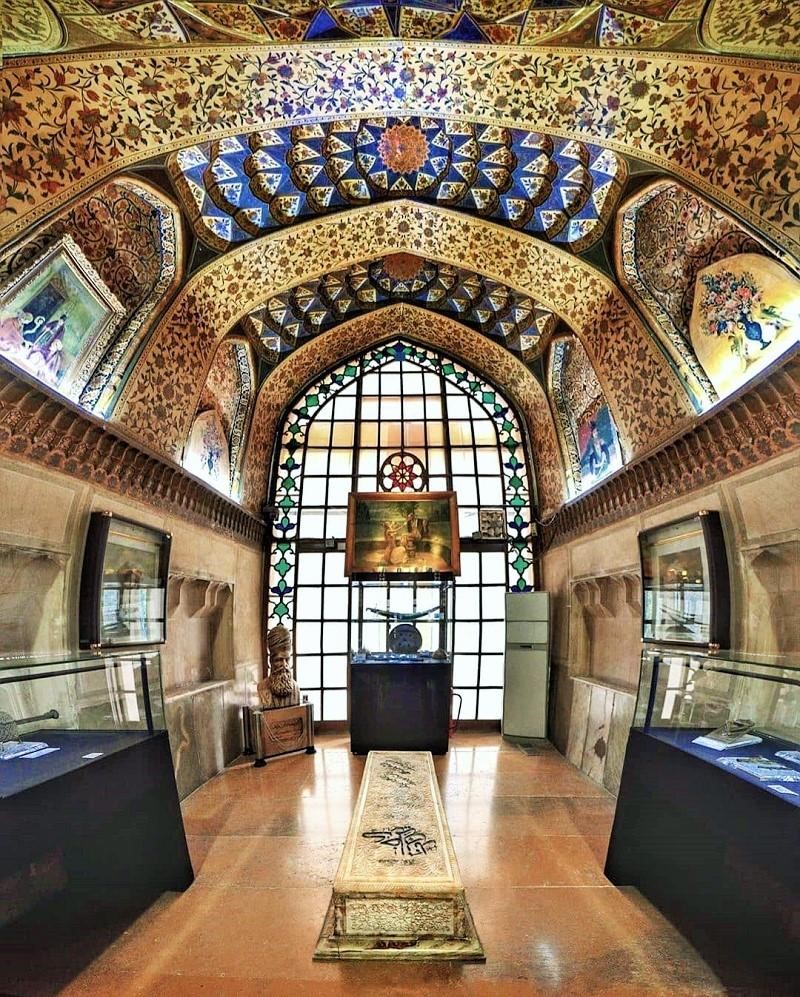
This museum displays the works of famous painters of the Zand period and the contemporary era. You can see the plinth stones from the Sun Palace with patterns from the Shahnameh just outside the museum. The tomb of Karim Khan Zand is one of the most important features of this museum that attracts many visitors. In addition to that, there are other objects in the museum, including Ghalam-dan (decorated pen cases) and a manuscript Quran.
Yazd Water Museum
Yazd Water Museum is located in one of the historical houses of Yazd city called Kolahdozha Home, with the purpose of showing the history of water in the past few thousand years. This museum occupies all the floors of the Kolahdoozha historical building including an opening in the basement that connects to the Rahim Abad and Zarch aqueducts which pass under the building. In addition, various instruments such as aqueduct digging tools and documents related to aqueducts are displayed in this museum.
Persian Gulf Regional Museum in Bushehr
Among Iran’s museums that have been set up in a modern style, the Persian Gulf Regional Museum in Sabzabad Mansion includes 15 different galleries where various ancient artifacts from different periods of history are displayed. These works were collected from different regions of the Persian Gulf and the provinces of Bushehr, Khuzestan, and Hormozgan.
Anthropological Iran Museums
These museums of Iran are a place to get to know Iran’s traditions and lifestyle in particular regions, some of which are mentioned below:
Kavir Anthropology Museum in Naeen
Pirnia historical house is a building from the Safavid period, which was repurposed as the Kavir or Naeen Anthropology Museum in 1994. In this museum, various artifacts such as agricultural tools, military equipment, etc., are displayed, which represent the culture of communities in the desert regions.
Asef Vaziri Mansion in Sanandaj
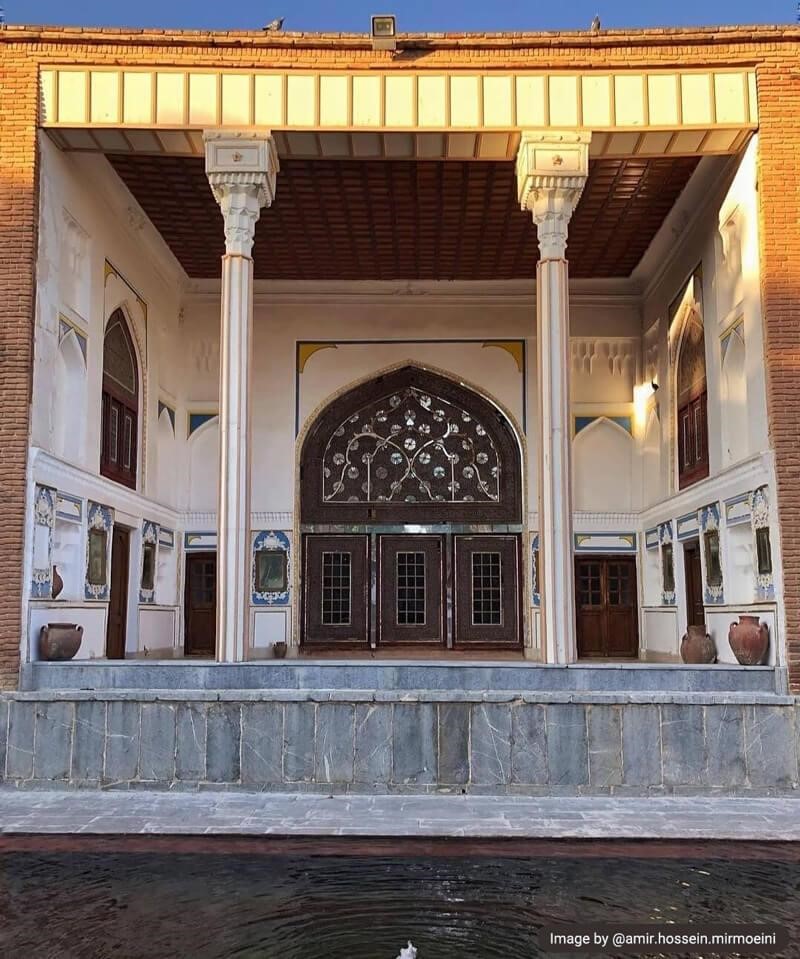
This mansion, which is also known as the Kurd House in Sanandaj, is a magnificent building with unique architecture, which now serves as the Museum of Anthropology of Kurdish Regions. For this purpose, many cultural and historical artifacts are on display there to introduce the Kurdish culture.
Abyaneh Anthropology Museum
A museum has been set up in the Abianeh village in Natanz City, Isfahan, which represents the culture and customs of the Abianeh region. Most of the objects on display in this museum have been donated by the people of the village. Of course, the museum in question is permanently closed.
Persian Gulf Anthropology Museum in Bandar Abbas
This museum, which is located in the Berkeh Haye Baran historical site in the south of Iran, was built with three floors that each display various artifacts. Each floor of the museum has been created to provide different services.
Chabahar Museum
The second floor of Chabahar Museum contains the anthropology section and the library. In this section, there are various replicas that display the customs, occupations of the Baloch people and their rich culture.
Ardabil Anthropology Museum
This museum, which was open to the public as Agha Naghi Bathhouse in the past, contains 33 wax sculptures of people wearing traditional local clothing. These sculptures show the tradition and style of clothing of the people of Ardabil and its surrounding areas.
Other Museums of Iran
There are various types of Iranian museums, but the list of the most significant ones is as follows:
Historic House Museums of Iran
Many of the historic houses in the country have been repurposed as museums of Iran due to their unique architecture. They are known as historic house museums. In the following, some of these museums of Iran are introduced:
Moghaddam Museum House in Tehran
This historic building dates back to the Qajar period. Mohammad Taqi Khan Ehtesaba-al-Molk, a high-ranking Qajar official, was the first owner of the house. Then, it was inherited by the youngest son of Ehtesaba-al-Molk, Dr. Mohsen Moghaddam, a professor of archeology at Tehran University. Dr. Moghaddam repurposed his family house into a museum that contains valuable historical and cultural artifacts he collected.
Solat Historical House in Abarkuh
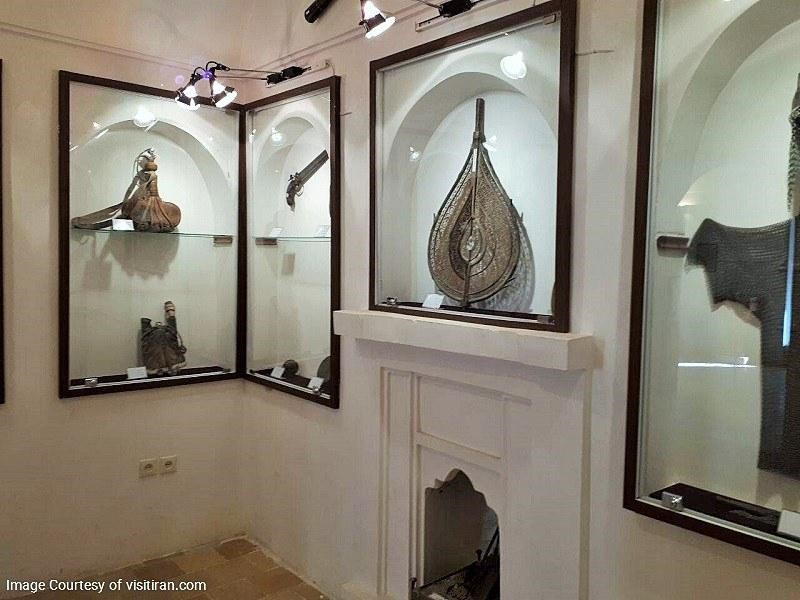
In 1997, after the Solat House was added to the Iran National Heritage List, an anthropology museum was founded there. The museum holds valuable artifacts from the post-Islamic periods, such as the Ilkhanate, Safavid, and Qajar periods which display the culture and lifestyle of ancient Iran.
Ali Mosi Historic House
This house, which belongs to one of the anonymous activists of the Mashrooteh (constitutional) movement, was turned into one of Iran museums in 2003 while being added to the Iran National Heritage List. There are photographs and images of the constitutional era along with some combat equipment on display in this museum.
House of Amir Nezam Garrousi
The building of Amir Nezam House was owned by Amir Nazam Garrousi, one of the politicians and writers of the Qajar period, now open to visitors as the Qajar museum. In this two-story house, there are many halls that display artifacts such as Khatam Kari (inlaying) dishware, metal artifacts, musical instruments, and more.
Constitution House of Tabriz
This building was originally owned by Haj Mehdi Kuzekanani, one of the famous merchants of Tabriz. With its service in the constitutionalist movement, it became known as Khaneh Mashrooteh (the Constitution House), and in the following years, it was branded a museum. This house is significant among Iran museums because of its importance and symbolic place in contemporary history.
Rakibkhaneh Mansion in Isfahan (Museum of Decorative Arts)
This Safavid-era mansion is a beautiful building with a very large yard, that was used as the royal stable of the Safavid kings in the past. In the following periods, it had various functions and was finally turned into a museum after the 1979 revolution. Currently, the said building serves as the Museum of Decorative Arts in Isfahan, displaying over 3,000 historical artifacts from the Safavid and Qajar periods.
Palace Museums in Iran
In the past, many Iranian rulers built palaces for their residences. Some of these historical buildings have been converted into palace museums of Iran. These historical buildings are now known as Palace Museums, and we will introduce some of them below:
Golestan Palace Compound
This complex, which contains several buildings that each have Andaruni (inner quarters) and Biruni (exterior) areas, dates back 440 years. The sections of the palace that have been converted into museums are as follows:
- Salam Hall or museum room, Aaj (Ivory) Hall or SofrehKhaneh, Abyaz (White) Palace or Ethnological Museum, Shams Ol-Emareh, and Badgir (wind catcher) mansion, Naqareh Khaneh which is a part of Salam Hall’s fountain room.
Niavaran Palace Compound
There are many buildings in the Niavaran Palace Compound, some of which have been converted into museums. Some of these museums are:
- Jahan Nama Museum of Niavaran Compound, the Private Royal Library Museum, Shams Palace (Royal Clothes Museum), and the Shah Exclusive Car Museum.
Sa’ad Abad Palace Compound
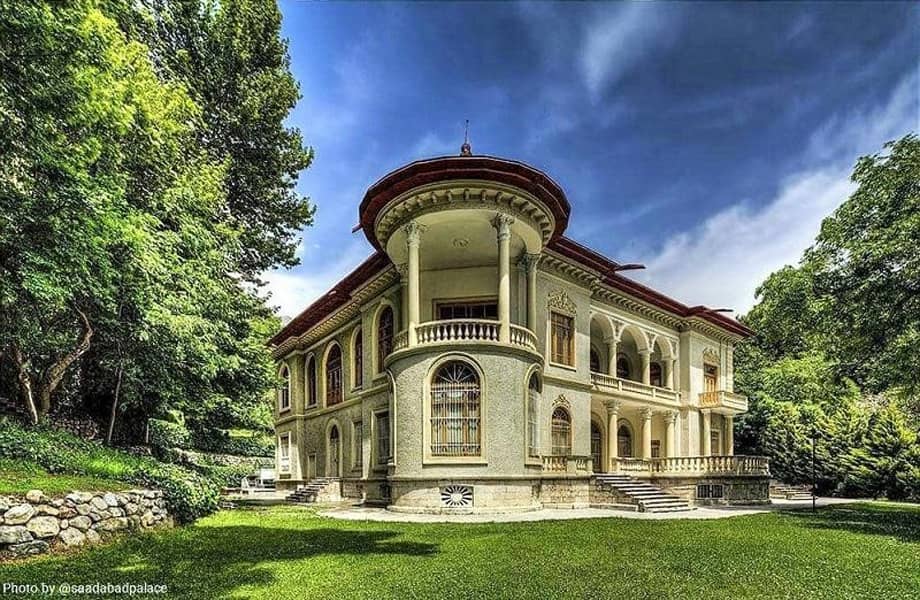
Out of all the Iran museums, this compound is significant because of its museums that specialize in various fields. These museums are:
- Mellat Palace Museum, Museum of Fine Arts, Hossein Behzad Museum, Reza Abbasi Museum or Abkar Museum, Mir Emad Museum, Sa’ad Abad Anthropology Museum, Water Museum, Military Museum in Shahram Palace, and Omidvar Brothers’ Museum.
Malek Abad Palace in Mashhad
Malik Abad Palace of Mashhad is located in a beautiful garden of the same name with a site of 1400 square meters. After the 1979 revolution, this palace was converted into a museum. The artifacts on display in the museum include exquisite carpets, tapestries, unique paintings, and more.
Ramsar Museum Palace or Marmar Palace
This palace was built in the Pahlavi period and houses a variety of museum topicss:
- Old Bathhouse Museum, Historical Documents Museum, Shah’s Palace, Anthropology Museum of the North of Iran, and Iran Specialized Ivory Museum.
Ali Qapu Palace in Isfahan
There is a magnificent building in Naqsh-e Jahan Square, Isfahan called Aali Qapu Palace, which belongs to the Safavid period. In the past, the entrance gate of this palace was the entry point for all buildings in Naqsh-e Jahan Square.
Chehel Sotoon Palace
During the reign of Shah Abbas Safavid, Iranian architects built a Kushk (small pavilion) in the middle of the Jahan Nama Garden, which is known today as the Chehel Sotoon or Chehel Sotoun Palace or the Chehel Sotoon Museum Garden. The main Iwan (porch) of this palace is supported by twenty pillars. Their reflection in the beautiful large pool of the mansion is why it is called Chehel Sotoon (forty pillars). It is one of the spectacular palace museums of Iran today.
Hasht Behesht Palace
During the reign of the Safavid king Suleiman I of Persia, a palace named Hasht Behesht (eight paradises) was built, which was converted into a Homayouni school during the Qajar period. This palace is one of the unique buildings of the Safavid period, which is also known by other titles such as Hasht Be Hasht and Hasht Dar Behesht. Hasht Behesht is now one of the museums of Iran that opened as a palace museum.
Museums of Historical Cars of Iran
Considering the importance of cars in human life and their impact on transportation, researching automobile history is surely interesting. It might be intriguing to know that the first cars were brought to Iran by Mozaffar ad-Din Shah Qajar. In fact, during his trips to Europe, this Qajar king brought two cars and chauffeurs (drivers) to Iran. According to some experts, the two mentioned cars were Manual Ford Coupes with solid tires and according to others, they were French Renault.
Although none of the two cars of Muzaffaruddin Shah remained intact, the royal family’s interest in them caused various cars to be imported into the country.
Currently, a large number of antique cars belonging to the years before the 1979 revolution have been collected in another one of Iran museums. This museum, which is known as the “Museum of Historical Cars of Iran”, is located in Tehran and aims to introduce all kinds of antique cars and their history. It is worth mentioning that the organization and reopening of this museum were carried out by the Mostazafan Foundation of the Islamic Republic in 2021.
In general, about 60 unique antique cars along with 2 carriages and 4 engines are kept in the Museum of Historical Cars of Iran. In the following, we introduce some of these cars that have attracted the attention of tourists:
- Naseruddin Shah Qajar’s royal carriage known as the Nasiri Carriage, special coronation carriage, Ahmad Shah Qajar’s Rolls Royce, Benz K500, red Morris Oxford, Lamborghini Countach, limousines, etc.
Iran Zoological Museums
In general, Iranian zoological museums are a place to display different species of taxidermy, synthetic, or live animals. These museums usually provide information about the habitat and lifestyle of animals including their feeding habits. Of course, in this field, different museums are active in Iran, which we will introduce below:
Paleontology Museum of Kerman
In the paleontology museum of Kerman, you can find small and large fossils of rare animals belonging to ancient geological periods, which are fascinating. These fossils belong to creatures such as sponges, corals, ammonites, starfish, and reptiles from the age of dinosaurs and beyond. This is one of the few Iran museums in this category.
Maragheh Museum of Paleontology
This museum is one of the open-air museums where fossils of extinct mammals can be visited. The Fossil Site of Maragheh covers a wide area from the outskirts of Maragheh to the south of Sahand Mountain to Tabriz, Mianeh, Varzeqan, and Bostan Abad. Due to the presence of valuable and unique fossils in this area, geologists have named it “Iran’s Fossil Paradise”.
Iran Wildlife and Nature Museum in Dar Abad
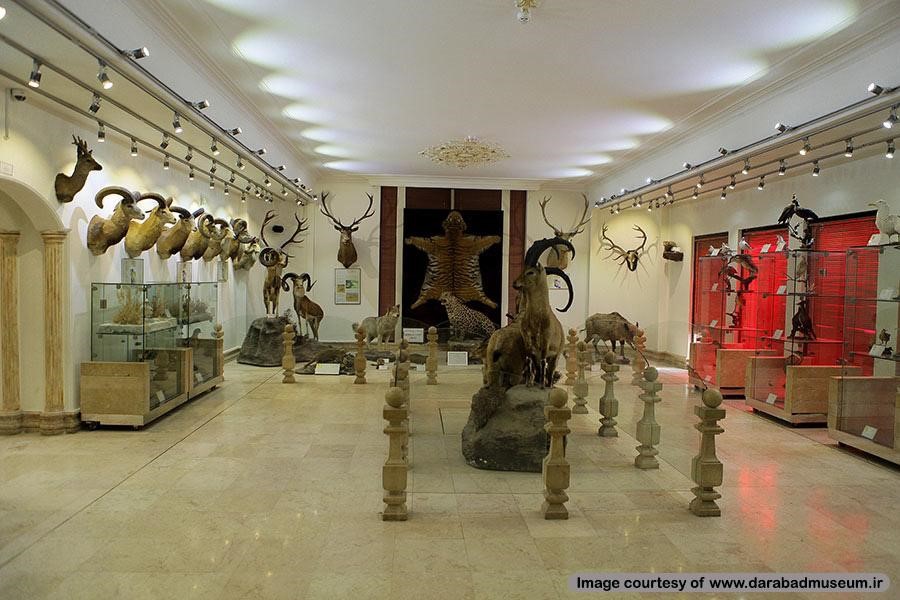
This museum is a place to display the evolution of different organisms, including animals, plants, bacteria, and even very small and microscopic creatures. You can observe more than hundreds of species of vertebrates and invertebrates in the museum and visit all kinds of live animals stationed in the open. In addition, the complex holds scientific workshops, training courses, exhibitions, and various festivals related to the museum that can be educational.
Iran Handicrafts Museums
There are many handicrafts in our country that represent the history, culture, and ancient civilization of Iran. In fact, the skill of making various handicrafts is part of the intangible cultural heritage of the country. Today, along with other Iran museums, specialized museums have been established to introduce Iran’s intangible cultural heritage, some of which include:
Tehran Handicrafts Museum
The museum’s building was one of the residences of the Pahlavi royal family before 1979. It was decided a few years after the revolution to utilize the building as a museum of leather handicrafts. After restoration in 1992, it was converted into a Calligraphy and Manuscript Museum in 1997. Sometime later, it was repurposed as the Handicrafts Museum of Tehran.
Qom Handicrafts Museum
This museum, which was established in one of the historical houses of Qom called Yazdan Panah House, exhibits the local handicrafts of Qom City. All these artifacts are on display in the two Shahneshin (elegant rooms) in the mentioned historical house. In the following, the categories of the most significant artifacts displayed in these museums of Iran are introduced:
- Pottery and ceramic products, wood inlaying, glass forming, copper and Toreutics products, beads, marquetry, precious stone carvings, and more.
Ardabil Handicrafts Museum
Another Iranian handicraft museum has been established in the historical bathhouse of Sheikh Safi Al-Din Ardabili’s Shrine. The building of this museum dates back to the Safavid period, and after numerous applications, it was turned into a handicrafts museum in 1999. In general, 300 pieces of handicrafts are displayed in the Ardabil handicrafts museum, organized into 25 general categories.
Iran Music Museums
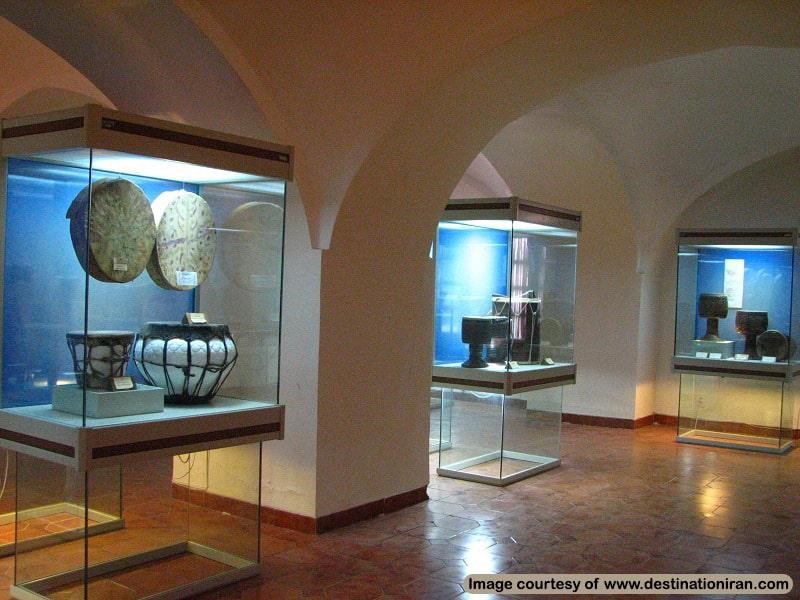
There are art museums in Iran specializing in Music history known as Iranian music museums. The purpose of establishing these museums is to introduce and preserve the works of famous musicians, as well as preserve traditional Persian music, some of which are listed below:
- Tehran Museum of Music
- Isfahan Music Museum
- Harandi Garden Museum or Museum of Traditional Instruments of Kerman
Iran Horror Museums
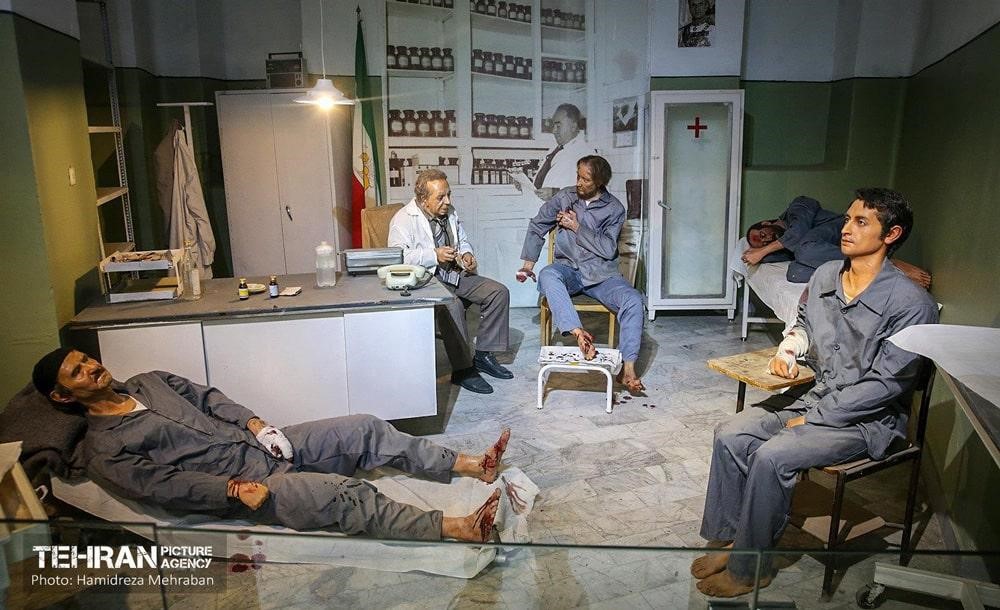
During the Pahlavi period and in 1932, a prison was built by order of Reza Shah, which was later used as a torture chamber for political prisoners. In this prison, many opponents of the Pahlavi regime were tortured by SAVAK or the Pahlavi secret police. After the revolution and the release of political prisoners, this prison was turned into a museum in the late 1970s.
Now, this museum is open to the public as the Iran Ebrat Museum in Tehran and is known as one of the horror museums of Iran. The museum is designed to take visitors on the same journey as the political prisoners, starting at the entrance and leading to the holding cells. For this purpose, different sections of the prison have remained intact that include:
- Personal belonging depository section, a photo room, various general public and solitary holdings, an infirmary, various torture rooms, a visitation chamber, and the warden’s room.
International and Iranian Virtual Museums
Museums are a place to display ancient artifacts and valuable objects that introduce us to the culture and customs of people from the past. Sometimes, we are not able to visit some museums, for example, foreign museums. Therefore, online Iranian museums provide the possibility to visit museums from home.
Encyclopedia Britannica has provided the following definition for a virtual museum:
“a collection of digitally recorded images, sound files, text documents, and other data of historical, scientific, or cultural interest that are accessed through electronic media.”
According to this definition, the museum visitor can choose a method to see the objects displayed in the museum. In the following list, we have introduced a number of virtual museums in Iran and the world:
Most Famous Iranian Virtual Museums
There are many virtual museums in our country, the following examples are among the most famous ones:
Virtual Tour of Iran National Museum
In this museum, there are two sections on archeology and the post-Islam era of Iran. In the first part, relics from the Paleolithic to the Sassanid period are on display. The Islamic era section of this museum contains artifacts related to the post-Islamic era. If you are a fan of virtual museums, you can visit this museum’s website to view ancient objects in 3D and in full detail.
Virtual Tour of Glassware and Ceramic Museum of Iran
This museum is one of the most visited museums in Tehran and is known as the first specialized glassware and ceramic museum. The number of ceramic and glass artifacts in the museum is about 2,000 which includes pottery and ceramic from different historical periods of Iran.
The most famous virtual museums in the world
Out of all the virtual museums in the world, we have presented the most famous ones in the following list:
Virtual Tour of Louvre Museum in France
This museum is one of the world’s most famous museums and is located in Paris, containing invaluable works of art. Among these works, we can mention ancient Egyptian sculptures, baroque portraits, and modern paintings.
Virtual Tour of the American Museum of Natural History
This museum is located in Manhattan, New York City, and exhibits various attractions ranging from extinct animals to marine life and geology. Visitors can take an online tour on the museum’s website.
Best Iran Museums
A number of museums of Iran are known as the best ones, which include:
The Tehran Museum of Contemporary Art
There are modern art masterpieces from the Post-World War II era until 2021. These masterpieces include works of art from the movements of abstract expressionism, pop art, minimalism, conceptualism, and surrealism.
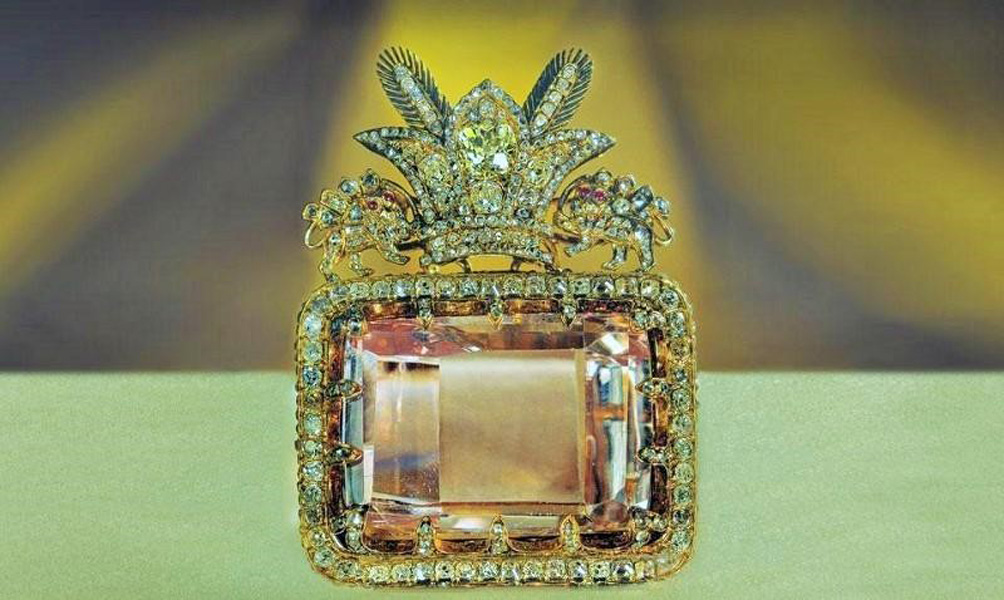
Treasury of National Jewels
This local museum contains royal jewelry collections from the Safavid era until today. The museum’s jewelry collection is considered part of Iran’s history and culture, and some date back to ancient and prehistoric times.
Carpet Museum of Iran
This museum is considered one of the best museums in Iran for containing some exquisite carpets of famous artists, which was established by the order of Farah Pahlavi. The purpose of founding this museum was to introduce a variety of Iranian handwoven carpets and also to show the diversity of this Iranian handicraft in recent historical periods. In addition to carpets, similar artifacts such as rugs are also kept in the Iranian Carpet Museum.
Iranian Historical Artifacts in Foreign Museums
In addition to the artifacts that we have in Iran museums, many ancient relics of Iranian history are held in museums abroad. In the following, we introduce the famous museums that contain Iranian historical relics:
The Most Famous Collection of Iranian Artifacts in The Louvre Museum
It is recorded that in a period of history, French archaeologists had legally received permission to explore Iranian historical sites from the Iranian government. In these years, they managed to seize a significant amount of pre-Islamic historical artifacts, which are currently displayed in the Louvre Museum in Paris, France.
In the early years of The Louvre’s establishment, it only contained a few examples of Iranian artifacts, such as the cup of Khosrow II, the Sassanid king. The number of these artifacts increased exponentially during the next hundred years.
The Most Famous Collection of Iranian Artifacts in The British Museum
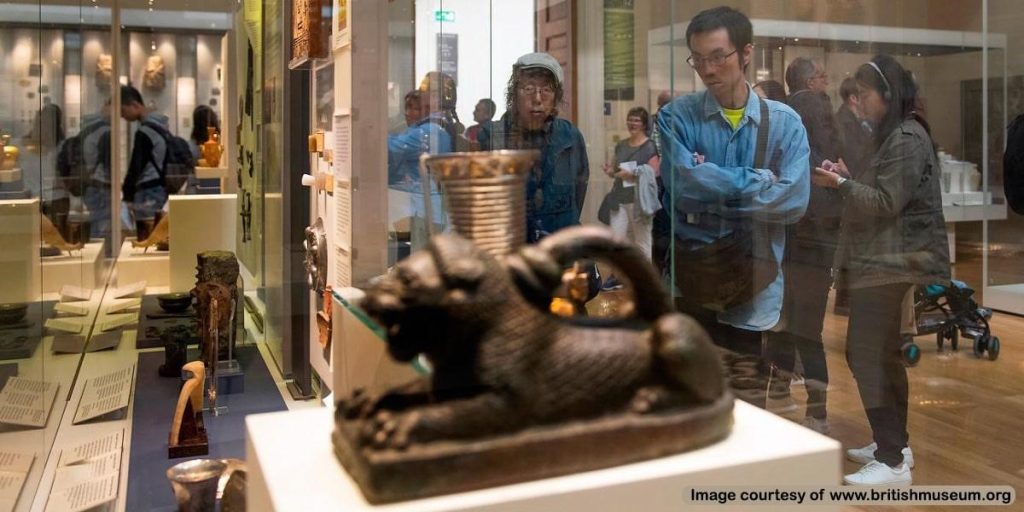
The British Museum in England houses more than 8 million artifacts from all over the world. In the meantime, the share of Iranian artifacts is high. According to the museum, it contains nearly 12,000 Iranian artifacts.
The Most Famous Iranian Artifacts in The Metropolitan Museum of Art, U.S.
This museum houses a large and rare collection of artifacts from the history of Islam and ancient Iran and is considered the most famous museum containing Iranian artifacts in America.
The Most Famous Iranian Artifacts in State Hermitage Museum, Russia
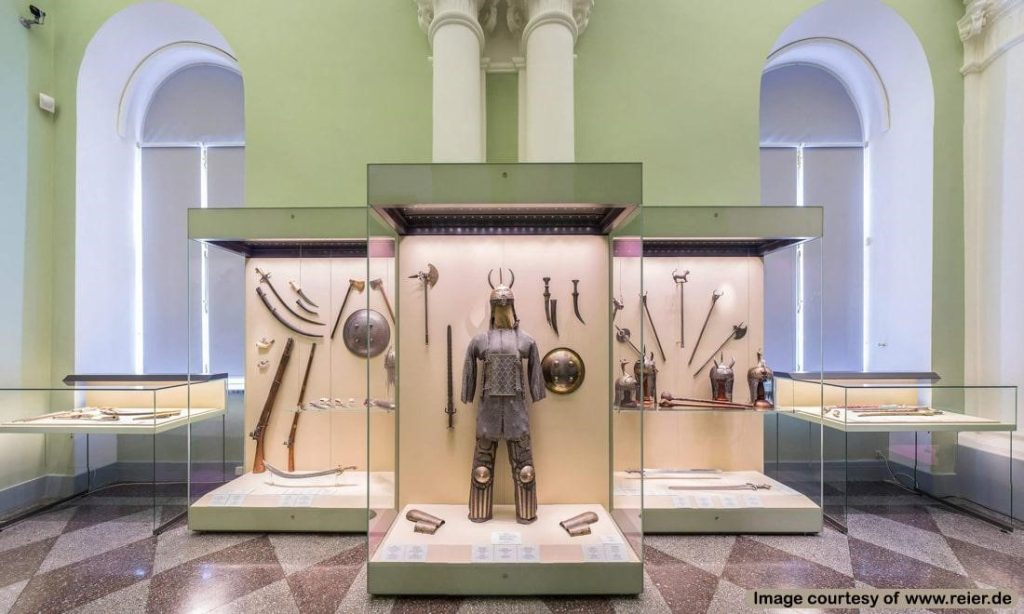
During the reign of Fath Ali Shah Qajar and based on the cultural trade agreement between Iran and Russia, many ancient artifacts were transported to Russia from Iran. Among all these artifacts, the Pazyryk carpet is considered the first woven carpet in the world, which dates back to the Achaemenid period. This carpet is one of the most important Iranian works in the State Hermitage Museum.
The Most Famous Iranian Artifacts in Pergamon Museum, Germany
The Iranian relics in Berlin’s Pergamon Museum are the fruits of archaeological excavations in the first decades of the 20th century in Ctesiphon, which are associated with the Sassanid period. In addition to that, the unique artifacts obtained from Taq Kasra in present-day Iraq were also discovered during these excavations and transferred to the Iranian section of this museum in Germany. Among these artifacts, we can mention a special plasterwork design that inspired the logo of the University of Tehran. Pieces of this plasterwork are kept in the Museum of Ancient Iran as well.
The Amu Darya or Oxus Treasure Collection Found in Tajikistan
A treasure collection from the Achaemenid period was found in the vicinity of the Jihun River in Tajikistan, whose ancient name is Amu Darya. This treasure includes many artifacts such as bracelets and armbands, embossed gold and silver plaques, a golden chariot with four horses, and more.
Famous Iranian Artifacts in Tokyo National Museum and Miho Museum in Japan
One of the largest museums in Japan, The Miho Museum contains more than thirty different Iranian artifacts from the Sassanid period and dozens of Achaemenid relics. In addition to that, we can also mention the Shosoin Treasures in the Tokyo National Museum. This collection belongs to the 8th century and includes many historical relics from different countries including Iran. It was collected by one of the Japanese emperors, Emperor Shōmu.
The International Council of Museums
The International Council of Museums (ICOM) is the only international organization specializing in the field of museums and museology. It focuses on the promotion and preservation of modern and historic natural and cultural heritage and tangible and intangible cultural heritage.
ICOM is active in Iran through a national committee that aims to establish professional and ethical standards for Iran museums. This committee provides consultations in the field of preserving cultural heritage and promoting awareness of the potential of museums. In general, the goals of Iran ICOM can be summarized as follows:
- Providing the necessary framework for increasing public awareness of the international concept of a museum and promoting Iranian museums in other countries.
- Creating a suitable platform for the improvement, transfer, and utilization of knowledge related to museum issues on a national scale
- Quantitative and qualitative development of specialized, local, national, and independent museums in Iran and the West Asia region
- Supporting the rights and interests of museums, identifying and preventing the decline of museums and cultural heritage sites
Iranian museums; A Unique Journey in History
Ancient Iranian artifacts are among the tools that our ancestors created with elegance and art. They represent the lifestyle, culture, and customs of their era. Iran Museums displaying relics from different periods give us the opportunity to learn more about Iranian culture and history. Destination Iran suggests that you visit these museums or take online tours of museums in Iran and around the world.
To read more:
- Jiroft Archaeological Museum and findings of ancient Jiroft hills
- Museum of History, audience of contemporary history of Iran
- Visit the Iranian National Art Museum in Tehran
- Malek Library and Museum of Tehran; One of the prominent historical works of Tehran
- Introduction to the Museum of the Islamic Council
- How well do you know Timurtash House (Tehran War Museum)?
- Familiarity with Salar Saeed Museum and Mansion or Sanandaj Museum
- Familiarization with the Museum of the Spectator of Time and its objects
- Lotfi Damghan House; The architecture and use of this traditional Iranian house
- Modares Museum and House; Its history, architecture and current use
- The most prominent objects of the Semnan Museum
- Getting to know the Shahroud Museum with the subject of archeology and anthropology
- Reza Abbasi Museum of Tehran and its sights
- Ardabil House Chinese Museum; The history and importance of its objects
- Sabzevar oil museum and relics of industrial heritage
- Asar Ahan Museum, Tabriz; Unique objects with an amazing history
- Fragments of Iranian art and architecture in the Palace of Mirrors in Yazd
- Getting to know the Falak Al-Flak Castle; Admirable legacy of the Sassanids
- What is the attraction of Shah Lafti Museum in Mashhad?
- Getting to know Shiraz Vakil bath and its 3 different parts
- Visiting Isfahan Contemporary Art Museum during Iran tour
- Isfahan Decorative Arts Museum and its objects
- In Tehran, visit the Water and Pottery Museum
- Visit the unique collection of the Tehran Museum of Anthropology
- Visit the Fars Famous Museum in Shiraz
- Getting to know Kashan National Museum and its most prominent objects
Frequently Asked Questions About Iran Museums
If you have any more questions about Iran’s museums, check the FAQs below. If you didn’t get your answer, post it in the comments below this post. We will answer it as soon as possible.
What is the most important museum in Iran?
The National Museum of Iran or the Museum of Ancient Iran is the first and most important museum in Iran that we recommend visiting.
What are the most popular Iranian museum websites?
There are many museum sites in Iran, examples of which are given below:
• Virtual tour of the Tehran Peace Museum
• Virtual tour of Sa’ad Abad Compound Art Museum
• Virtual museum of children’s art
• Virtual tour of Moghaddam Museum
• Virtual tour of the Water and Pottery Museum
• Virtual Museum of Ancient Iran
• Virtual Museum of Holy Defense and…
What are the famous museum websites in the world?
There are many museum websites, but the following are some of the most famous examples:
• Virtual tour of the British Museum
• Prado Museum of Spain or Museo Nacional del Prado
• Freud Museum in London
• The Museum of the American Revolution
• Melbourne Virtual Holocaust Museum
• Louvre museum website
• Virtual Museum of American Natural History
• and…
How many museums are there in Iran?
There are around 600 private and national museums in Iran. Considering the country’s rich culture, increasing the number of museums is considered an appropriate and proper measure to promote Iranian culture and history.
Source: Destination Iran